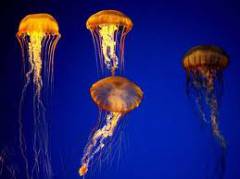The Journey of the Jellyfish
Without a brain, a heart, nor teeth… jellyfish are fearsome predators! They immobilize their prey with the help of their venomous tentacles.
However, the exact evolutionary origin of the jellyfish form is still poorly understood, is it sexual or viviparous, or by budding for example?

The jellyfish, this intriguing creature scares the world with its stinging filaments and fascinates science and mythology by its existence.
- In mythology Medusa succumbed to the child of Zeus! (Meduse being the name of jellyfish in French)
- In the oceans, facing a lack of maritime predators suffocating by plastic bags, the jellyfish sadly changed the maritime balance.
- Jellyfish is one of the oldest animals in the world. The Big Bang started about 4,5 billion years ago. Unicellular livings were born 2 billion years later and around 555 million years, the size of organisms increased. One cell passes to several… we are witnessing an explosion of diversity: jellyfish, algae, and sponges…
Mythology:
Perseus the son of Zeus and Danae is the hero who killed Medusa! Perseus grew up with the king Polydectes of this island until his adulthood. The king wanted to court Danae, but found that Perseus was on the way. He used ploy to keep him away by asking him to cut off the head of Medusa, a Gorgon, which at a glance changed men to stone!
Athena hated Medusa so she helped Perseus in his mission. She armed him and guided him to a field where he found the Gorgons asleep. With one billhook hit, he cut off the head of Medusa. Then Pegasus, the winged horse, from the blood of Medusa came, and Perseus mounted it to escape.
Her hair was intertwined snakes. Her face has the power to petrify any mortal who looks at it. After being beheaded by Perseus, her mask (gorgonian) is given to Athena who fixed it on her shield. Representation of the gorgonian will be used for a long time as a protection against the evil eye.
Oceans:
The "seventh plastic continent" is a huge garbage patch growing in the North Pacific Ocean, one third the size of the United States or six times the size of France. Immediately formed to mind the image of a compact cluster of gigantic plastic bags, bottles, cans and other containers ... that choke turtles and tuna, jellyfish predators.
But the jellyfish primarily benefit from the overfishing of small pelagic fish. Sardines, herring, anchovies ... that are feeding like cnidarians of zooplankton. They are their main competitors for food.
Jellyfish now have free rein and can thrive. In addition, small fish eat the eggs and larvae of jellyfish. Normally, they regulate the population. Without them, nothing hinders the proliferation of gelatinous animals.
Will we soon be forced to eat jellyfish? Since the early 2000s, these gelatinous organisms invade several seas like the Sea of Japan, the Black Sea, the Mediterranean, etc. This is a cyclical phenomenon, due to changes in current or global warming...
A dozen species of jellyfish are eaten dried in Asia, especially in Japan (kurage), they are typically sliced and served as a salad.
Time Travel:
Jellyfish have appeared on Earth about 650 million years ago during the Ediacaran and probably among the first metazoans.
Jellyfish are part of the planktonic compartment. They spend their entire lives in open water. The weight of the body is composed of 98% water and 2% solids (compared to 63% of water in the human body).
The term meduse (jellyfish) is a vernacular name for the free forms of many groups of cnidarians and thus opposing the polyps’ forms.
Some jellyfish can bud other jellyfish on the edge of the umbrella, but the majority of asexual reproduction is made from the polyp. At the time of sexual reproduction, jellyfish become true floating gonads, all their food being dedicated to producing these glands. It then releases the sperm (if male) that disperse in the ocean and fertilize the ovules (external fertilization, except for the Stygiomedusa gigantea which is viviparous), then dies.
There are more than 1000 species of jellyfish, their numbers increase, perhaps as a result of global warming. The jellyfish Turritopsis nutricula reaches 200 years. If the fountain of youth exists, this jellyfish family would have found the source. After the age of sexual maturity is reached, when the environment is poor in nutrients, it is able to stop or even reverse the growth cycle to be young again; this growth cycle rejuvenation fascinates researchers.
What to do when encountering one of these animals?
The tentacles are covered with small vesicles, cnidocysts, each equipped with a sensory cilium projecting the toxin when it is stimulated. So avoid activating cnidocysts that are not yet open. First by removing the tentacles if any left on the skin, possibly with a glove or pliers, then rinsing the area with seawater. Never rinse with fresh water and rub because it stimulates the release of the venom. Then gently scrapes the skin with the flat part of a knife or a stiff card to remove the remaining cnidocysts, after making a patch of wet sand to trap the cnidocysts.
Hot water can also, later, ease the pain, because the heat degrades the venom. Provided you do not burn yourself because the skin is numbed by the bite. Lack of a better solution, we once used to advise to urinate on the wound...The Journey of the Jellyfish !
Rached Trimèche
Edito ASTROLABE sept 2014
